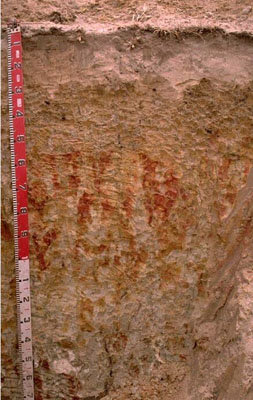LSWW01
|
Location | Telopea Downs Road, Servicetown North, western Victoria | ||
|
Landform | Rise (minor) | |||
|
Geology | Quaternary Woorinen Formation: aeolian dune sand, calcareous clay | |||
|
Element | Hillslope | |||
Horizon | Depth (cm) | Description | ||
A1 | 0–10 | Brown (10YR5/3); loamy fine sand; single grain (structureless); loose consistence when dry; hydrophobic; pH 6.1; abrupt and wavy boundary to: |  Vertic & Bleached-Sodic, Calcic, Grey CHROMOSOL | |
A2 | 10–25 | Very pale brown (10YR7/4); sand; conspicuously bleached when dry; pH 7.2; sharp and wavy boundary to: | ||
B21 | 25–55 | Pale brown (10YR6/3) with many coarse faint reddish yellow mottles; medium clay (sandy) strong coarse angular blocky, parting to medium angular blocky structure; smooth ped-fabric; few (2-5%) soft calcium carbonate segregations; pH 8.7 (completely disperses after reworking); abrupt and wavy boundary to: | ||
B22 | 55–105 | Brownish yellow (10YR6/6) with many very coarse prominent dark yellowish brown and light grey mottles; sandy clay loam; massive (structureless); very few soft calcium carbonate segregations; pH 9.3 (strongly dispersive when dry); clear and wavy boundary to: | ||
B31 | 105–140 | Light grey (10YR7/1) with common coarse distinct brownish yellow mottles; light fine sandy clay loam; massive (structureless)to weakly structured; very few (<2%) soft calcareous segregations; pH 9.7; clear and wavy boundary to: | ||
B32 | 140–180+ | Light grey (5Y7/1) with common very coarse prominent dark yellowish brown mottles; light medium clay; moderate to strong coarse polyhedral, parting to medium polyhedral structure; smooth ped-fabric; few slickensides; few calcareous segregations; pH 9.8. | ||
Management Considerations | ||||
| ||||
Horizon | Depth (cm) | pH (water) | pH (CaCl2) | EC dS/m | NaCl % | Exchangeable Cations cmol-/kg | Wilting Point (pF4.2) | Coarse Sand % | Fine Sand % | Silt % | Clay % | |||
Ca | Mg | K | Na | |||||||||||
A1 | 0–10 | 6.1 | 5.5 | 0.1 | 2.4 | 0.4 | 0.4 | 0.1 | 5.3 | 10.3 | 80.6 | 3 | 3.5 | |
A2 | 10–25 | 7.2 | 6.2 | <0.05 | - | - | - | - | 1.4 | 10.6 | 84.2 | 1.5 | 2.5 | |
B21 | 25–55 | 8.7 | 8 | 0.16 | 9.6 | 4.6 | 1.8 | 0.8 | 18.0 | 7 | 40.8 | 1.5 | 46 | |
B22 | 55–105 | 9.3 | 8.2 | 0.15 | 3.6 | 3.4 | 1.1 | 1.1 | 9.8 | 8 | 65.2 | 2 | 22.5 | |
B31 | 105–140 | 9.7 | 8.5 | 0.2 | ||||||||||
B32 | 140–180+ | 9.8 | 8.7 | 0.46 | <0.05 | |||||||||



